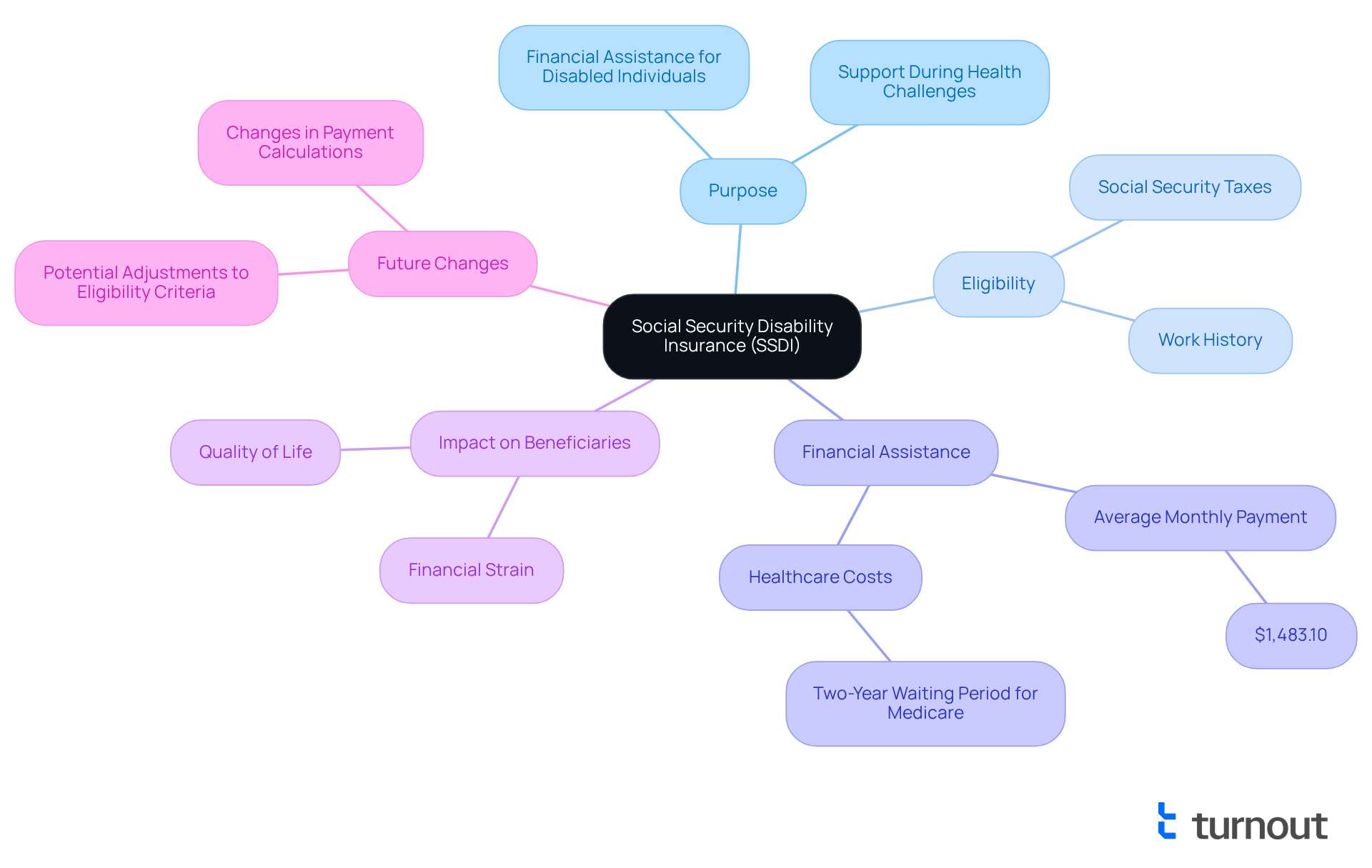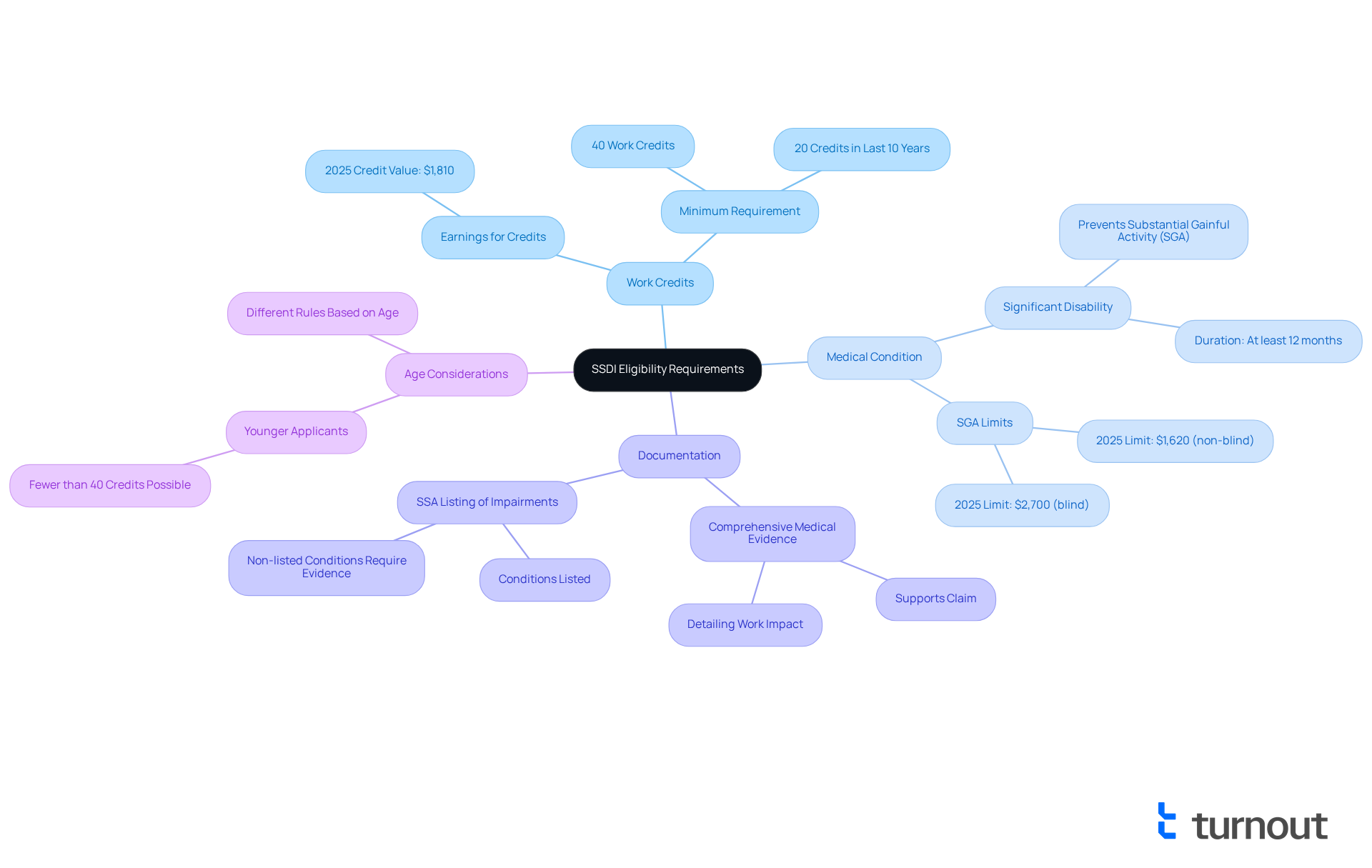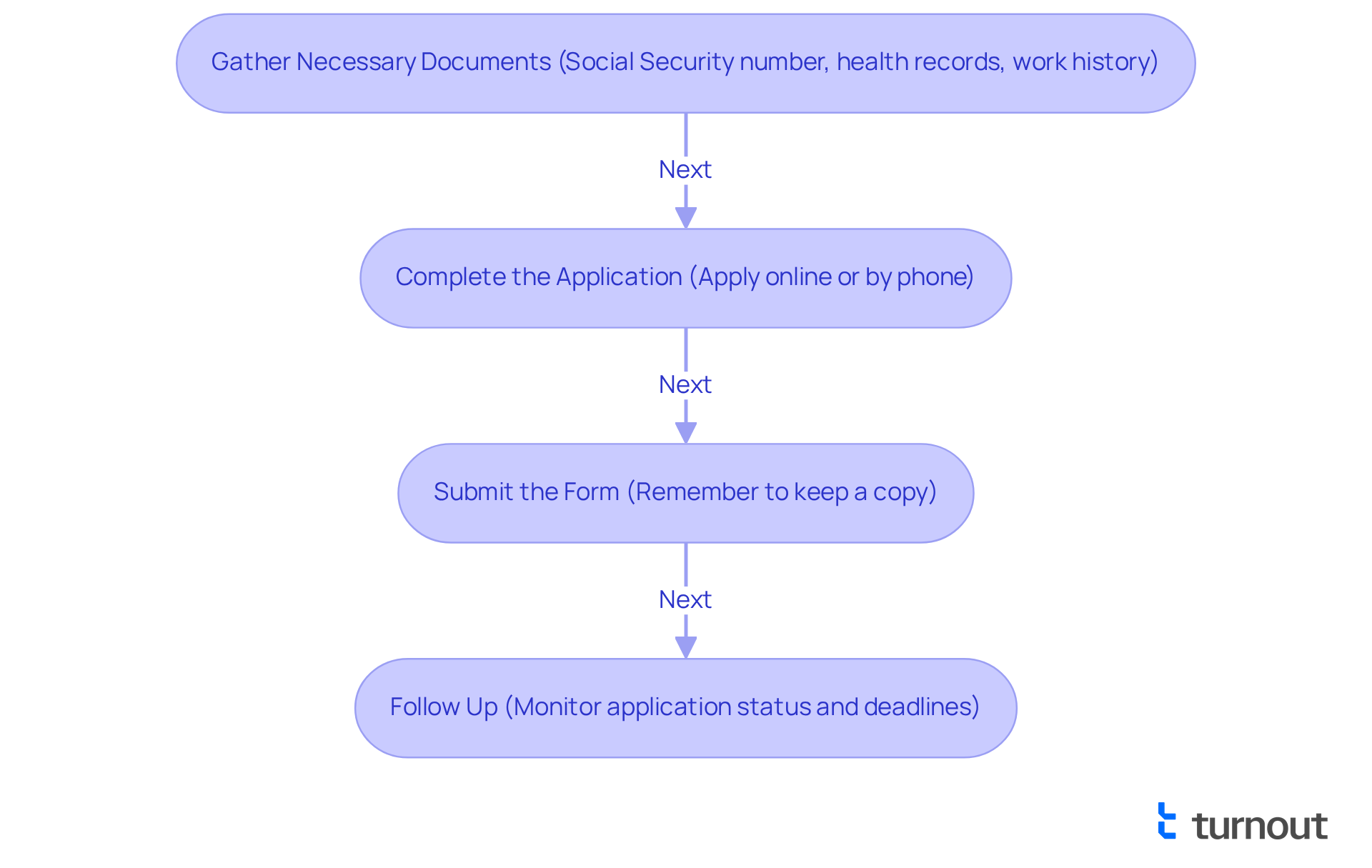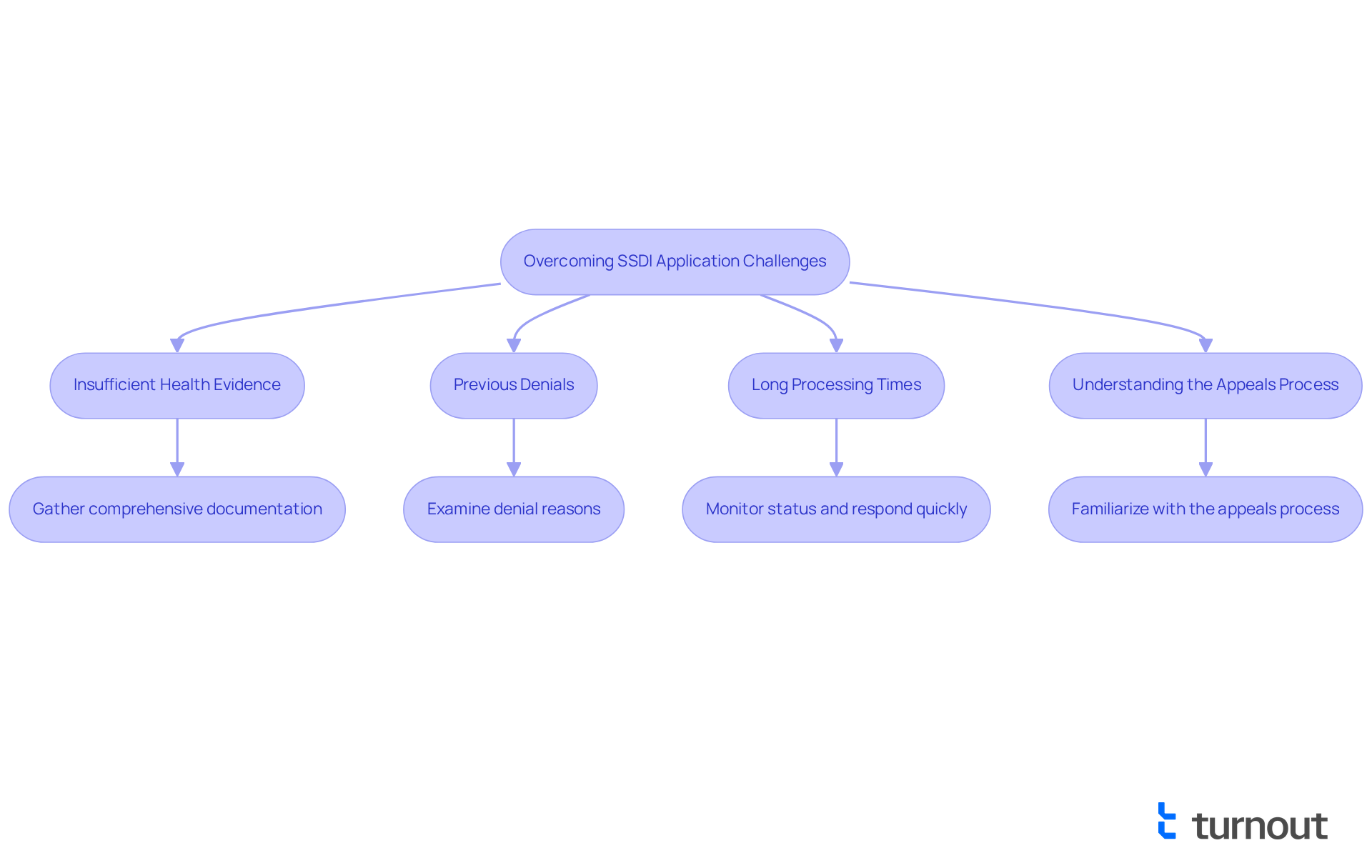Overview
Navigating the process of securing Social Security Disability benefits can feel overwhelming, but you are not alone in this journey. To qualify, applicants must meet specific eligibility criteria. This includes:
- Having a sufficient work history
- Providing comprehensive medical documentation
- Demonstrating that their disability prevents substantial gainful activity
Understanding the application process is crucial. Many face common challenges, and thorough documentation is key to overcoming them. We understand that it can be disheartening when initial claims are denied, but knowing the steps to take can significantly improve your chances of approval.
Remember, we’re here to help you through this process. By acknowledging your struggles and providing supportive information, we aim to empower you to take action with confidence. You deserve the benefits you need to support your well-being.
Introduction
Navigating the landscape of Social Security Disability Insurance (SSDI) can feel overwhelming for those grappling with serious health challenges. We understand that millions of Americans depend on this vital program for financial support, making it essential to grasp the steps needed to secure these benefits. However, the application process often presents complexities and potential pitfalls that can lead to frustration and, unfortunately, denial.
What are the key requirements and strategies that can empower you to successfully claim your rightful benefits? You're not alone in this journey, and we're here to help.
Understand Social Security Disability Insurance (SSDI)
Social Security Disability Insurance is a vital national program designed to provide financial assistance to those unable to work due to serious health issues. In 2025, it is estimated that around 5 million Americans will benefit from this crucial support, underscoring the program's importance in helping individuals navigate challenging times. To qualify, applicants need to show a work history that includes paying Social Security taxes. These disability support payments are meant to help cover living costs, healthcare expenses, and other essential needs, with the average monthly payment reaching $1,483.10 for beneficiaries.
Understanding how to get social security disability benefits is essential for successfully navigating the application process. We encourage you to familiarize yourself with the various forms of assistance available, the duration of support, and how these provisions can impact your financial situation. It's important to note that in 2025, potential changes to the disability support program may involve adjustments to eligibility criteria and payment calculations, reflecting ongoing discussions about the program's sustainability and the need for reform.
Real-life examples illustrate how disability support can significantly impact individuals' lives. Many beneficiaries depend on these payments to maintain their quality of life, especially given the financial strain from the two-year waiting period for Medicare eligibility. As conversations about healthcare reform progress, there is hope for future changes that could reduce this waiting period, further enhancing support for those in need. By staying informed about how to get social security disability and the disability benefits program's evolving landscape, you can better prepare for the application process and secure the benefits you deserve.

Determine Eligibility Requirements for SSDI
Navigating how to get social security disability can feel overwhelming. We understand that you may have concerns, and it's important to know what requirements you need to meet:
-
Work Credits: Typically, a minimum of 40 work credits is required, with at least 20 earned in the last 10 years. In 2025, you’ll earn one credit for every $1,810 in covered earnings. This highlights the importance of maintaining consistent employment and paying Social Security taxes.
-
Medical Condition: Your disability must be significant enough to prevent you from engaging in any substantial gainful activity (SGA) for at least 12 months. For 2025, the SGA limit is $1,620 per month for non-blind individuals and $2,700 for those who are statutorily blind.
-
Documentation: Comprehensive medical evidence is crucial to support your claim, detailing how your condition affects your ability to work. This documentation is vital, especially if your condition isn’t listed in the Social Security Administration's (SSA) Listing of Impairments.
-
Age Considerations: Different rules may apply based on your age, particularly for younger applicants. For instance, younger workers may qualify for SSDI with fewer than 40 credits, depending on when the disability occurred.
Understanding how to get social security disability criteria is essential for assessing your eligibility before you begin the submission process. It's common to feel uncertain, especially with around two-thirds of initial disability claims being rejected. By ensuring you meet these criteria and have the necessary documentation, you can significantly improve your chances of approval. Remember, you are not alone in this journey, and we're here to help you through it.

Complete the SSDI Application Process
Navigating how to get social security disability submission process can feel overwhelming, but you’re not alone in this journey. Here’s how to approach it with confidence:
-
Gather Necessary Documents: Start by collecting essential documents such as your Social Security number, health records, and a detailed work history for the past 15 years. It’s also important to have supporting medical documentation, like clinic visit notes and test results, to strengthen your submission when learning how to get social security disability.
-
Complete the Application: You can apply online through the Social Security Administration (SSA) website or by calling their toll-free number. If you choose to apply online, just follow the prompts to fill out the form accurately. Keep in mind that in 2025, approximately 65-70% of initial SSDI requests are denied, so knowing how to get social security disability with clarity and completeness is vital.
-
Submit the Form: Once you’ve completed your application, send it off. If you’re applying online, make sure to receive a confirmation. For mail submissions, remember to keep a copy for your records. Recent trends show that online submissions are becoming more popular, as they simplify the process and reduce the chances of errors.
-
Follow Up: After your submission, it’s important to monitor the status of your application through your SSA account or by reaching out to the SSA directly. Be ready to provide any additional information if needed. Remember, if you want to know how to get social security disability, the average wait time for a decision is 3 to 5 months, and there’s a five-month waiting period before payments begin after approval. Keeping track of deadlines and maintaining clear documentation of your health status can significantly improve your chances of success.
We understand that this process can be daunting, but taking these steps can help you feel more prepared and supported.

Overcome Common Challenges in the SSDI Application
Many applicants face challenges when applying for SSDI, and we understand how to get social security disability can be an overwhelming process. Here are some common issues and supportive solutions to help you navigate your journey:
-
Insufficient Health Evidence: It’s crucial to have comprehensive documentation that clearly outlines your condition and its impact on your ability to work. Many applicants struggle to provide the extensive medical records and evaluations required by the SSA, which can complicate their claims. We’re here to help—Turnout's trained nonlawyer advocates can assist you in gathering and organizing this documentation effectively, especially if you need guidance on how to get social security disability.
-
Previous Denials: If you’ve faced rejection before, it’s important to examine the reasons for refusal and address those concerns in your new submission. Providing additional evidence or clarifications that directly respond to the issues raised can significantly enhance your chances of approval. Turnout can guide you in understanding how to get social security disability reasons and help you strengthen your submission.
-
Long Processing Times: Patience is key, as the SSDI request process can take up to 8 months, with over 1 million claims currently pending at the SSA. It’s common to feel anxious during this time, so frequently verify your status and respond quickly to any inquiries for more details to prevent further delays. Turnout's services include monitoring your submission and ensuring prompt responses to inquiries.
-
Understanding the Appeals Process: If your application is denied, remember that you can appeal the decision. Familiarizing yourself with how to get social security disability, including the steps involved in the appeals process, is essential, as timely action can significantly improve your chances of a favorable outcome. Seeking support and guidance from Turnout during this stage can help you navigate the complexities effectively, giving you the best chance at securing your benefits.
Note: Turnout is not a law firm and does not provide legal advice.

Conclusion
Navigating the complexities of Social Security Disability Insurance (SSDI) can feel overwhelming, especially for those facing health challenges. It's essential to understand the eligibility requirements, the application process, and the common obstacles that may arise. By doing so, you can significantly enhance your chances of securing these vital benefits. Millions rely on SSDI for their livelihood, and grasping the nuances of this program not only empowers you as an applicant but also underscores the importance of informed advocacy in the face of potential reforms.
We understand that meeting specific work credits and medical condition criteria can be daunting. Thorough documentation is crucial, as is having strategies in place to overcome the common challenges in the application process. With statistics showing a high rate of initial claim denials, preparation and understanding become paramount. Utilizing available resources and support systems can bolster your likelihood of a successful application, especially with the anticipated changes to SSDI in the coming years.
Ultimately, staying informed and proactive is vital for anyone considering SSDI benefits. By equipping yourself with knowledge and seeking assistance when needed, you can navigate the application process with confidence. The journey may be challenging, but remember, the potential for financial security and an improved quality of life makes this pursuit worth undertaking. You are not alone in this journey; we’re here to help you every step of the way.
Frequently Asked Questions
What is Social Security Disability Insurance (SSDI)?
Social Security Disability Insurance is a national program that provides financial assistance to individuals who are unable to work due to serious health issues.
How many Americans are expected to benefit from SSDI in 2025?
It is estimated that around 5 million Americans will benefit from Social Security Disability Insurance in 2025.
What are the eligibility requirements for SSDI?
To qualify for SSDI, applicants need to demonstrate a work history that includes paying Social Security taxes.
What do SSDI payments help cover?
SSDI payments are intended to help cover living costs, healthcare expenses, and other essential needs.
What is the average monthly payment for SSDI beneficiaries?
The average monthly payment for SSDI beneficiaries is approximately $1,483.10.
Why is it important to understand how to apply for SSDI benefits?
Understanding how to apply for SSDI benefits is essential for successfully navigating the application process and ensuring that individuals can access the support they need.
What changes are expected in the SSDI program by 2025?
Potential changes to the SSDI program may involve adjustments to eligibility criteria and payment calculations, reflecting ongoing discussions about the program's sustainability and the need for reform.
How does the two-year waiting period for Medicare eligibility affect SSDI beneficiaries?
Many SSDI beneficiaries rely on these payments to maintain their quality of life, especially given the financial strain caused by the two-year waiting period for Medicare eligibility.
Is there hope for changes to the Medicare waiting period for SSDI beneficiaries?
Yes, there is hope for future changes that could reduce the waiting period for Medicare eligibility, enhancing support for those in need.
How can individuals prepare for the SSDI application process?
By staying informed about the SSDI program and its evolving landscape, individuals can better prepare for the application process and secure the benefits they deserve.




